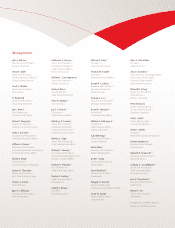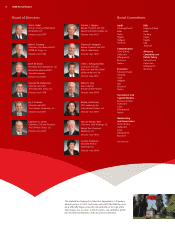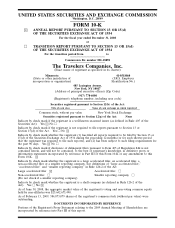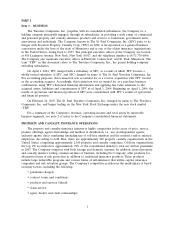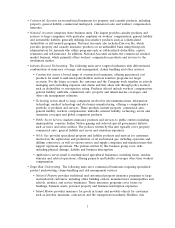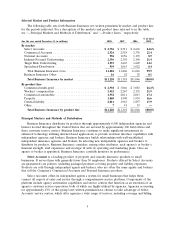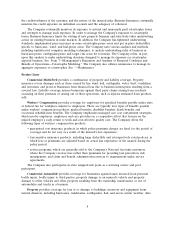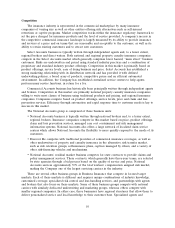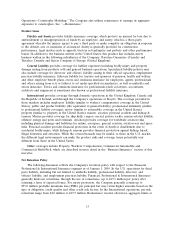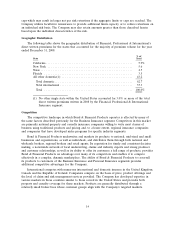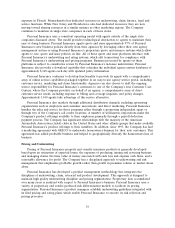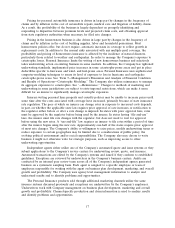Travelers 2008 Annual Report Download - page 19
Download and view the complete annual report
Please find page 19 of the 2008 Travelers annual report below. You can navigate through the pages in the report by either clicking on the pages listed below, or by using the keyword search tool below to find specific information within the annual report.Marine, Excess Casualty, Boiler & Machinery, and Global Accounts, which are described in more detail
earlier in this report.
Products are distributed primarily through the same agents and brokers servicing Select Accounts
and Commercial Accounts, as well as specialized agents and brokers with expertise in certain of these
products.
Specialized Distribution distributes admitted and excess and surplus lines property and casualty
products predominantly through selected wholesale agents, both on a brokerage and managing general
underwriting basis, and through selected program agents. Brokers, general agents and program agents
operate in certain markets that are not typically served by the Company’s appointed retail agents, or
they maintain certain affinity arrangements in specialized market segments. The wholesale excess and
surplus lines market, which is characterized by the absence of rate and form regulation, allows for more
flexibility to write certain classes of business. In working with wholesale or program agents on a
brokerage basis, Specialized Distribution underwrites the business and sets the premium level. In
working with wholesale or program agents on a managing general underwriting or program manager
basis, the agents produce and underwrite business that conforms to underwriting guidelines that have
been specifically designed for each facility or program.
Pricing and Underwriting
Pricing of Business Insurance property and casualty insurance products is generally developed
based upon an estimation of expected losses, the expenses of producing, issuing and servicing business
and managing claims, the time value of money associated with such loss and expense cash flows, and a
reasonable allowance for profit. The Company has a disciplined approach to underwriting and risk
management that emphasizes profitable growth rather than premium volume or market share.
Business Insurance has developed an underwriting and pricing methodology that incorporates
underwriting, claims, engineering, actuarial and product development disciplines for particular
industries. This approach is designed to maintain high quality underwriting and pricing discipline. It
utilizes proprietary data gathered and analyzed with respect to its Business Insurance business over
many years. The underwriters and engineers use this information to assess and evaluate risks prior to
quotation. This information provides specialized knowledge about specific industry segments. This
methodology enables Business Insurance to streamline its risk selection process and develop pricing
parameters that will not compromise its underwriting integrity.
For smaller businesses, Select Accounts uses a process based on industry classifications to allow
agents and field underwriting representatives to make underwriting and pricing decisions within
predetermined classifications, because underwriting criteria and pricing tend to be more standardized
for these smaller exposures.
A portion of business in this segment, particularly in National Accounts and Construction, is
written with large deductible insurance policies. Under workers’ compensation insurance contracts with
deductible features, the Company is obligated to pay the claimant the full amount of the claim. The
Company is subsequently reimbursed by the contractholder for the deductible amount and is subject to
credit risk until such reimbursement is made. At December 31, 2008, contractholder receivables and
payables on unpaid losses associated with large deductible policies were each approximately
$6.34 billion. Retrospectively rated policies are also used for workers’ compensation coverage. Although
the retrospectively rated feature of the policy substantially reduces insurance risk for the Company, it
introduces additional credit risk to the Company. Premium receivables from holders of retrospectively
rated policies totaled approximately $322 million at December 31, 2008. Significant collateral, primarily
letters of credit and, to a lesser extent, cash collateral, trusts or surety bonds, is generally requested for
large deductible plans and/or retrospectively rated policies that provide for deferred collection of
deductible recoveries and/or ultimate premiums. The amount of collateral requested is predicated upon
7


